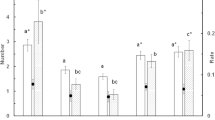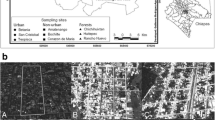Abstract
Almost all chiropteran species are nocturnal, but some species are occasionally active during the daytime. We conducted radio-tracking surveys and direct observations of the Ryukyu flying fox, Pteropus dasymallus, in two different habitats—urbanized and forested areas—on a subtropical island from April 2002 to January 2006. We recorded the departure time and return time from/to day roosts as well as behavioral time budgets during the night. The departure and return times shifted in correspondence with seasonal changes in sunset and sunrise times. The Ryukyu flying fox tended to depart earlier in summer when the night length was shorter, suggesting that it adjusts its active period by departing earlier. On the contrary, the amount of foraging performed by the bats in urbanized areas decreased in the summer when fruits of Ficus microcarpa were more abundant, suggesting that the bats adjust their behavioral time budgets in line with local food availability. Daytime activity was observed only in the forested area. In conclusion, the duration of Ryukyu flying fox activity was found to primarily depend on seasonal changes in the light–dark cycle, and this bat may adjust its behavioral time budget according to local food availability and the intensity of human activities.


Similar content being viewed by others
References
Cox PA (1983) Observations on the natural history of Samoan bats. Mammalia 47:519–523
Duvergé P, Jones G, Rydell J, Ransome R (2000) Functional significance of emergence timing in bats. Ecography 23:32–40
Erkert HG (1982) Ecological aspects of bat activity rhythms. In: Kunz TH (ed) Ecology of bats. Plenum, New York, pp 201–242
Frafjord K (2013) Influence of night length on home range size in the northern bat Eptesicus nilssonii. Mamm Biol 78:205–211
Funakoshi K, Kunisaki T, Watanabe H (1991) Seasonal changes in activity of the northern Ryukyu fruit bat Pteropus dasymallus dasymallus. J Mamm Soc Jpn 16:13–25
Funakoshi K, Watanabe H, Kunisaki T (1993) Feeding ecology of the northern Ryukyu fruit bat, Pteropus dasymallus dasymallus, in a warm-temperate region. J Zool Lond 230:221–230
Grant GS, Craig P, Trail P (1997) Cyclone-induced shift in foraging behavior in flying foxes in American Samoa. Biotropica 29:224–228
Ishii N (1982) Mammals of Minami-Iwojima. In: Nature Conservation Bureau of the Environment Agency (ed) Conservation reports of the Minami-Iwojima wilderness area, Tokyo, Japan. Nature Conservation Bureau of the Environment Agency, Tokyo, pp 225–242 (in Japanese)
Ives CD, Lentini PE, Threlfall CG, Ikin K, Shanahan DF, Garrard GE, Bekessy SA, Fuller RA, Mumaw L, Rayner L, Rowe R, Valentine LE, Kendal D (2016) Cities are hotspots for threatened species. Global Ecol Biogeogr 25:117–126
Kinjo K, Izawa M (2009) Pteropus pselaphon. In: Ohdachi SD, Ishibashi Y, Iwasa MA, Saitoh T (eds) The wild mammals in Japan. Shoukadoh Book Sellers and the Mammalogical Society of Japan, Kyoto, pp 56–57
Kinjo K, Nakamoto A (2009) Pteropus dasymallus. In: Ohdachi SD, Ishibashi Y, Iwasa MA, Saitoh T (eds) The wild mammals in Japan. Shoukadoh Book Sellers and the Mammalogical Society of Japan, Kyoto, pp 52–53
Law BS (1993) Roosting and foraging ecology of the Queensland blossom bat (Syconycteris australis) in north-eastern New South Wales: flexibility in response to seasonal variation. Wildlife Res 20:419–431
Lee Y, McCracken G (2001) Timing and variation in the emergence and return of Mexican free-tailed bats, Tadarida brasiliensis mexicana. Zool Stud 40:309–316
Maruyama K (1982) Roosting and activity of Pteropus dasymallus daitoensis in March. Majaa 2:27–29 (in Japanese)
McConkey KR, Drake DR (2006) Flying foxes cease to function as seed dispersers long before they become rare. Ecology 87:271–276
Mech LD (1983) Handbook of animal radio-tracking. University of Minnesota Press, Minneapolis
Miyawaki A (1989) Vegetation of Japan, vol 10. Shibundo, Okinawa (in Japanese with English summary)
Morrison DW (1978) Lunar phobia in a neotropical fruit bat, Artibeus jamaicensis (Chiroptera: Phyllostmidae). Anim Behav 26:852–855
Nakamoto A (2008) Foraging ecology of the Orii’s flying-fox Pteropus dasymallus inopinatus. Ph.D. Thesis, University of the Ryukyus, Nishihara
Nakamoto A, Kinjo K, Izawa M (2007) Food habits of Orii’s flying-fox, Pteropus dasymallus inopinatus, in relation to food availability in an urban area of Okinawa-jima Island, the Ryukyu Archipelago, Japan. Acta Chiropterol 9:237–249
Nakamoto A, Sato A, Kinjo K, Izawa M (2011) Population growth of Orii’s flying fox, Pteropus dasymallus inopinatus, on Okinawa-jima Island. Jpn J Conserv Ecol 16:45–53 (in Japanese with English abstract)
Nakamoto A, Kinjo K, Izawa M (2012) Ranging patterns and habitat use of a solitary flying fox (Pteropus dasymallus) on Okinawa-jima Island, Japan. Acta Chiropterol 14:387–399
Nakamoto A, Kinjo K, Izawa M (2015) Dietary plasticity in the Ryukyu flying fox on a subtropical island at the northern range limit of Pteropus. Acta Chiropterol 17:105–116
Pierson ED, Elmqvist T, Rainey WE, Cox PA (1996) Effects of tropical cyclonic storms on flying fox populations on the south pacific island of Samoa. Conserv Biol 10:438–451
Presley SJ, Willig MR, Castro-Arellano I, Weaver SC (2009) Effects of habitat conversion on temporal activity patterns of phyllostomid bats in lowland Amazonian rain forest. J Mamm 90:210–221
Russo D, Ancillotto L (2014) Sensitivity of bats to urbanization: a review. Mamm Biol 80:205–212
Sakaguchi N, Toyama M (1992) Home range and habitat utilization of the Daito flying-fox, Pteropus dasymallus daitoensis, in Kita-Daitojima Island, Ryukyu archipelago. In: Okinawa Prefecture Board of Education (ed) Daito-Okomori (Daito flying-fox), survey reports on natural monuments of Okinawa Prefecture, vol 31. Okinawa Prefecture Board of Education, Naha, pp 105–141 (in Japanese)
Schlaepfer MA, Runge MC, Sherman PW (2002) Ecological and evolutionary traps. Trends Ecol Evol 17:474–480
Speakman J (1990) The function of daylight flying in British bats. J Zool 220:101–113
Speakman J (1995) Chiropteran nocturnality. Symp Zool Soc Lond 67:187–201
Suzuki H, Kawakami K, Fujita T (2007) Flying fox of Minami-Iwo-To, Volcano Isles, the Bonin Islands. Ogasawara Res 33:89–104 (in Japanese with English summary)
Tait J, Perotto-Baldivieso HL, McKeown A, Westcott DA (2014) Are flying-foxes coming to town? Urbanisation of the spectacled flying-fox (Pteropus conspicillatus) in Australia. PLoS One 9:e109810
Thies W, Kalko EKV, Schnitzler HU (2006) Influence of environment and resource availability on activity patterns of Carollia castanea (Phyllostmidae) in Panama. J Mammal 87:331–338
Tidemann CR (1987) Notes on the flying-fox, Pteropus melanotus (Chiroptera: Pteropodidae), on Christmas Island, Indian Ocean. Aust Mammal 10:89–91
Welbergen JA (2006) Timing of the evening emergence from day roosts of the grey-headed flying-fox, Pteropus poliocephalus: the effects of predation risk, foraging needs, and social context. Behav Ecol Sociobiol 60:311–322
Williams NSG, Mcdonnell MJ, Phelan GK, Keim LD, van der Ree R (2006) Range expansion due to urbanization: increased food resources attract grey-headed flying-foxes (Pteropus poliocephalus) to Melbourne. Austral Ecol 31:190–198
Acknowledgments
We thank Professors M. Tsuchiya and A. Hagihara, University of the Ryukyus, for their valuable comments throughout our study. Suggestions from two anonymous reviewers were also very helpful in regard to improving the manuscript. We also thank the Ministry of the Environment for allowing us to conduct this survey. This study was partially supported by a Grant-in-Aid from the Nippon Life Insurance Foundation, a Sasakawa Scientific Research Grant from the Japan Science Society, and the 21st Century COE program of the University of the Ryukyus.
Author information
Authors and Affiliations
Corresponding author
About this article
Cite this article
Nakamoto, A., Kinjo, K. & Izawa, M. Activity patterns of the Ryukyu flying fox on a subtropical island: responses to seasonal changes in night length. J Ethol 34, 321–328 (2016). https://doi.org/10.1007/s10164-016-0478-4
Received:
Accepted:
Published:
Issue Date:
DOI: https://doi.org/10.1007/s10164-016-0478-4




